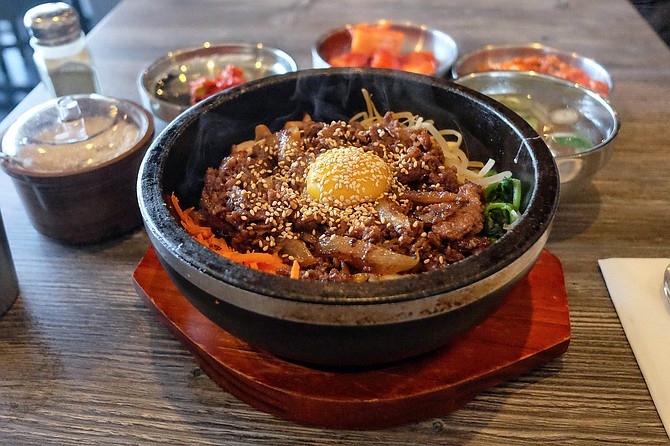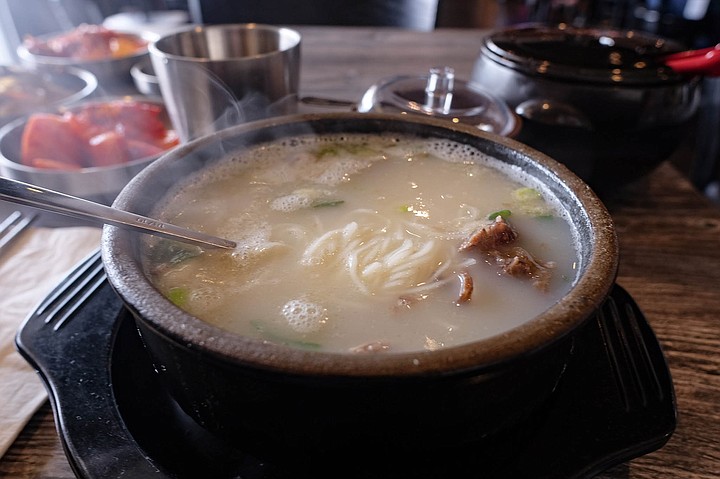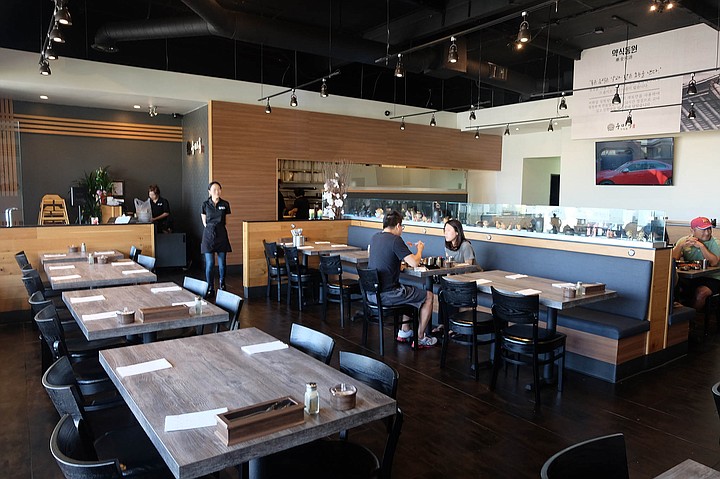 Facebook
Facebook
 X
X
 Instagram
Instagram
 TikTok
TikTok
 Youtube
Youtube

If you’ve grown complacent with tonkotsu ramen, but still want bone broth in your life, check out the latest place adding to the bounty of Korean restaurants in Kearny Mesa. Called Woomiok, its main thing is the bone broth soup dish seolleongtang, which looks intimidating to pronounce but sounds similar enough to “so long tong” that I think we all can manage.
I’ve indulged too often in tonkotsu pork broth, but the seolleongtang bone broth is new to me, stewed from oxtail. Bone broth is said to be super nutritious because it turns out the same stuff that makes cattle bones and cartilage healthy makes our bones and joints healthy; stuff like calcium, phosphorous, and collagen. Bone marrow likewise possesses a ton of nutrients, so when you stew a bunch of cow and ox bones for 24 hours, as the people at Woomiak describe, you wind up with the carnivore’s answer to cold pressed juice. They say it cures a hangover, but knock on wood I haven’t tested that theory in the three months the place has been open.

The soup comes out in a stone bowl, the broth milky and steaming hot, almost too cloudy to reveal the noodles, meats, and gelatinized joints swimming within. It’s unsalted, which means the first spoonful will surprise the unexpecting with a deadpan umami impression. Relish that for a moment. Along with the banchan dishes laid out on your table will be a small bowl of rock salt to flavor the soup to your preference.

Of course, you’ll want to do so incrementally, careful not to over-salt, and this will give you an opportunity to get intimate with the broth in a way you might not otherwise if you immediately dug straight in to the noodles and meat. Slurp a little, add a little salt, then slurp a little more. It’ll make you more aware how the salt brings out the other flavors to ratchet things up to your palate’s happy place. Next time around, it’ll be more fun to repeat the process, except with the spicy version of Woomiok’s broth to heat you up.

You get control over which solids go inside the soup as well (the green onions and other garnishes help), and if you’re collagen-obsessed you can order a version with brisket, ox knee, cheek, and shank. I found it fun to challenge my sensibilities, but if you’re not already into chewing on gelatinous knee joints, starting with the brisket-only soup is the safer bet. Better yet, opt for the beef and cabbage seolleongtang, and get some fiber out of the deal. At 12 to 13 bucks a bowl, it’s a pretty good deal once you factor in the well-presented banchan dishes including sesame noodles and a house kimchi with some kick to it.
I don’t know that seolleongtang can supplant ramen as the noodle soup of my heart’s desire, and I don’t see Woomiak spawning a craze resulting in hundred seolleongtangeateries opening around San Diego. But now that I know what seolleongtang is, I’m certain I’ll be craving more soon.
And in the event I don’t, it’s all right. Woomiok isn’t a one-trick pony. It offers another steaming bowl I can get behind: a bibimbap with bulgogi, carrots, spinach, onions, sprouts, mushroom, egg, and loads of sesame seeds. It’s nothing new to San Diego, it won’t spark any nutritional trends, and doesn’t make for as good a story as the seafood pancake with mussels, shrimp, and calamari. But it’s everything I want in a hot stone bowl at a Korean restaurant, and it delivers. If you need me, I’ll be the boring Korean food fan eating marinated beef in the corner.


If you’ve grown complacent with tonkotsu ramen, but still want bone broth in your life, check out the latest place adding to the bounty of Korean restaurants in Kearny Mesa. Called Woomiok, its main thing is the bone broth soup dish seolleongtang, which looks intimidating to pronounce but sounds similar enough to “so long tong” that I think we all can manage.
I’ve indulged too often in tonkotsu pork broth, but the seolleongtang bone broth is new to me, stewed from oxtail. Bone broth is said to be super nutritious because it turns out the same stuff that makes cattle bones and cartilage healthy makes our bones and joints healthy; stuff like calcium, phosphorous, and collagen. Bone marrow likewise possesses a ton of nutrients, so when you stew a bunch of cow and ox bones for 24 hours, as the people at Woomiak describe, you wind up with the carnivore’s answer to cold pressed juice. They say it cures a hangover, but knock on wood I haven’t tested that theory in the three months the place has been open.

The soup comes out in a stone bowl, the broth milky and steaming hot, almost too cloudy to reveal the noodles, meats, and gelatinized joints swimming within. It’s unsalted, which means the first spoonful will surprise the unexpecting with a deadpan umami impression. Relish that for a moment. Along with the banchan dishes laid out on your table will be a small bowl of rock salt to flavor the soup to your preference.

Of course, you’ll want to do so incrementally, careful not to over-salt, and this will give you an opportunity to get intimate with the broth in a way you might not otherwise if you immediately dug straight in to the noodles and meat. Slurp a little, add a little salt, then slurp a little more. It’ll make you more aware how the salt brings out the other flavors to ratchet things up to your palate’s happy place. Next time around, it’ll be more fun to repeat the process, except with the spicy version of Woomiok’s broth to heat you up.

You get control over which solids go inside the soup as well (the green onions and other garnishes help), and if you’re collagen-obsessed you can order a version with brisket, ox knee, cheek, and shank. I found it fun to challenge my sensibilities, but if you’re not already into chewing on gelatinous knee joints, starting with the brisket-only soup is the safer bet. Better yet, opt for the beef and cabbage seolleongtang, and get some fiber out of the deal. At 12 to 13 bucks a bowl, it’s a pretty good deal once you factor in the well-presented banchan dishes including sesame noodles and a house kimchi with some kick to it.
I don’t know that seolleongtang can supplant ramen as the noodle soup of my heart’s desire, and I don’t see Woomiak spawning a craze resulting in hundred seolleongtangeateries opening around San Diego. But now that I know what seolleongtang is, I’m certain I’ll be craving more soon.
And in the event I don’t, it’s all right. Woomiok isn’t a one-trick pony. It offers another steaming bowl I can get behind: a bibimbap with bulgogi, carrots, spinach, onions, sprouts, mushroom, egg, and loads of sesame seeds. It’s nothing new to San Diego, it won’t spark any nutritional trends, and doesn’t make for as good a story as the seafood pancake with mussels, shrimp, and calamari. But it’s everything I want in a hot stone bowl at a Korean restaurant, and it delivers. If you need me, I’ll be the boring Korean food fan eating marinated beef in the corner.
Comments